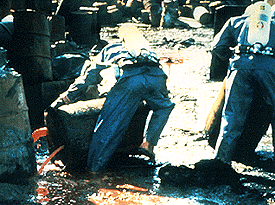 |
- Many liquids are hazardous in contact with the skin. They
either damage the skin or they are easily absorbed through the skin. It is important to
remember that chemicals that can damage or be absorbed through the skin will have this
effect on all skin, not just the hands.
- The degree of hazard associated with a liquid depends on its
characteristics and how it is handled. For example, inhalation is the primary route for a
chemical to enter the body. Its vapor pressure is important in determining the liquid
degree of hazard. Liquids with a low vapor pressure may create a low airborne
concentration. Liquids with a high vapor pressure may produce high airborne
concentrations. The hazard level of an airborne concentration depends in part on the
chemical's toxicity.
|

